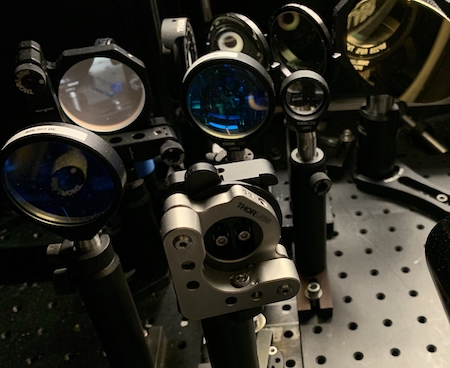 Intense pulses of radiation spanning the 0.1-10 THz range are vital in the discovery and control of exotic phases of matter. The THz-matter interaction at high field strength can result in spectacular nonlinear effects, such as harmonic generation, renormalization of the low (meV) and high (eV) energy electrodynamics, or coherent structural reorganizations. It thus become crucial to establish an exquisite level of control over the properties of the incident THz field, especially its intensity, spectral content, and polarization state. The key principle to achieve high THz intensity in table-top experiments is based on the nonlinear optical process known as “optical rectification”. When a femtosecond laser beam in the near-infrared impinges with sufficient pulse energy on a nonlinear crystal, its frequency content can sometimes be down-converted to the THz range. The accurate choice of the pump laser parameters, pumping geometry, and nonlinear crystal type determines the maximum achievable field strength and spectral content of the generated THz transient. Subsequent manipulation of the THz beam with suitable THz optics can lead to full control over its polarization state. While significant improvements have been made in the generation of high-field THz pulses, long-standing challenges remain that limit the versatility of quantum material control.
Intense pulses of radiation spanning the 0.1-10 THz range are vital in the discovery and control of exotic phases of matter. The THz-matter interaction at high field strength can result in spectacular nonlinear effects, such as harmonic generation, renormalization of the low (meV) and high (eV) energy electrodynamics, or coherent structural reorganizations. It thus become crucial to establish an exquisite level of control over the properties of the incident THz field, especially its intensity, spectral content, and polarization state. The key principle to achieve high THz intensity in table-top experiments is based on the nonlinear optical process known as “optical rectification”. When a femtosecond laser beam in the near-infrared impinges with sufficient pulse energy on a nonlinear crystal, its frequency content can sometimes be down-converted to the THz range. The accurate choice of the pump laser parameters, pumping geometry, and nonlinear crystal type determines the maximum achievable field strength and spectral content of the generated THz transient. Subsequent manipulation of the THz beam with suitable THz optics can lead to full control over its polarization state. While significant improvements have been made in the generation of high-field THz pulses, long-standing challenges remain that limit the versatility of quantum material control.
 In our lab, we are engineering novel solutions to overcome some of the most stringent constraints intrinsic to high-field THz technology. This will in turn enable us to investigate and control quantum materials with unprecedented flexibility. Once our THz transients are ready to operate in experiments, we will benefit from their high field strengths to implement nonlinear THz experiments, such as THz third harmonic generation and multidimensional THz spectroscopy. Another research direction will involve the study of THz-induced dynamics in quantum materials with advanced photonic probes that can resolve subtle spectroscopic fingerprints over specific spectral ranges.
In our lab, we are engineering novel solutions to overcome some of the most stringent constraints intrinsic to high-field THz technology. This will in turn enable us to investigate and control quantum materials with unprecedented flexibility. Once our THz transients are ready to operate in experiments, we will benefit from their high field strengths to implement nonlinear THz experiments, such as THz third harmonic generation and multidimensional THz spectroscopy. Another research direction will involve the study of THz-induced dynamics in quantum materials with advanced photonic probes that can resolve subtle spectroscopic fingerprints over specific spectral ranges.
Selected publications:
